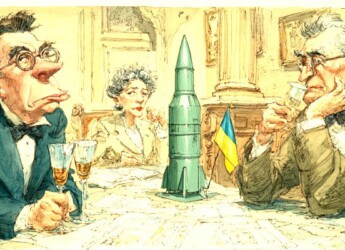|
|
Content Assessment: No Limits? Ukraine Conflict Assessments in Maps (June 23 – 27, 2022)
Information - 93%
Insight - 91%
Relevance - 90%
Objectivity - 91%
Authority - 94%
92%
Excellent
A short percentage-based assessment of the qualitative benefit of the post highlighting the recent Ukraine conflict assessments in maps from the Institute for the Study of War.
Editor’s Note: One of the most accurate and detailed sources for ongoing updates on the Ukraine crisis is the Ukraine Conflict Update from the Institute for the Study of War. The Institute for the Study of War (ISW) is a 501(c)(3) organization and produces strictly non-partisan, non-ideological, fact-based research. ISW seeks to promote an informed understanding of war and military affairs through comprehensive, independent, and accessible open-source research and analysis. ISW’s research is made available to the general public, military practitioners, policymakers, and media members. Providing a daily synthesis of key events related to the Russian aggression against Ukraine, ISW updates may benefit cybersecurity, information governance, and legal discovery professionals as they follow the business, information technology, and legal trends and trajectories impacted by and stemming from the current Ukraine conflict.
Assessment and Maps*
Ukraine Conflict Assessments – An Overview in Maps
- Institute for the Study of War (ISW), Russia Team
- Critical Threats Project (CTP), American Enterprise Institute
General Assessment Background Info
- ISW systematically publishes Russian campaign assessments that include maps highlighting the assessed control of terrain in Ukraine and main Russian maneuver axes.
- These maps augment daily synthetic products that cover key events related to renewed Russian aggression against Ukraine.
The Russian Offensive Campaign Assessments
- June 27, 2022
- By Kateryna Stepanenko, Karolina Hird, Mason Clark, George Barros, and Grace Mappes
A Russian missile strike hit a shopping mall in a residential area of Kremenchuk, Poltava Oblast on June 27, likely killing many civilians. Ukrainian sources stated that over 1,000 civilians were inside the mall at the time of the strike, and officials are still clarifying the number of casualties. The Kremenchuk strike follows a wider intensification of Russian missile strikes against Ukrainian infrastructure and civilian targets in recent days. Advisor to the Ukrainian Ministry of Internal Affairs Vadym Denisenko stated on June 26 that Russian forces have begun a campaign of massive and largely indiscriminate missile strikes against Ukrainian cities, which echoes statements made by an unnamed US defense official on June 27 that Russian forces are increasingly relying on artillery and missile strikes to advance operations in Ukraine. As Russian forces continue to burn through their supply of high-precision weaponry, such attacks that cause substantial collateral civilian damage will likely escalate.
Russian military authorities continue to seek ways to replenish their increasingly exhausted force capabilities without announcing general mobilization. An unnamed senior US defense official stated on June 27 that Russian forces are likely running low on senior military leaders and are relying more heavily on retired officers and reserves to replace officer casualties. The UK Ministry of Defense similarly reported that Russian forces will likely rely heavily on reserve echelons, namely the Combat Army Reserve (BARS) and Human Mobilization Resource, in order to galvanize volunteer support and fill out the third battalion tactical group (BTG) within regular (and depleted) brigades. As ISW has previously assessed, such reserves are unlikely to provide Russian forces with meaningful regeneration of force capabilities.
Key Takeaways:
- Russian forces struck a shopping mall in Kremenchuk as part of a recent escalation in strikes against Ukrainian infrastructure and cities.
- Russian forces made incremental advances southwest of Lysychansk near the T1302 Bakhmut-Lysychansk highway but have not entirely severed Ukrainian lines of communication into Bakhmut.
- Russian forces made measured advances during offensive operations to the east of Bakhmut.
- Ukrainian forces repelled Russian offensives north of Slovyansk.
- Russian forces made limited and localized attacks along contested frontlines around Kharkiv City but did not make any advances on June 27.
- Ukrainian counteroffensives along the Southern Axis continue to force Russian troops to prioritize defensive operations along the line of contact.
- Russian occupation authorities are taking steps to strengthen economic control of occupied territories and force Ukrainian civilians to switch to the ruble.
- June 26, 2022
- By Karolina Hird, Kateryna Stepanenko, Mason Clark, and Grace Mappes
Russian forces conducted a massive missile strike against the Schevchenkivskyi district of Kyiv on June 26, likely to coincide with the ongoing summit of G7 leaders. This is the first such major strike on Kyiv since late April and is likely a direct response to Western leaders discussing aid to Ukraine at the ongoing G7 summit, much like the previous strikes on April 29 during UN Secretary-General Antonio Guterres’ visit to Kyiv. Ukrainian government sources reported that Russian forces targeted infrastructure in the Shevchenkivskyi district using X101 missiles fired from Tu-95 and Tu-160 bombers over the Caspian Sea and noted the Russian attack was an attempt to “show off” their capabilities. Open-source Twitter account GeoConfirmed stated that the strikes targeted the general vicinity of the Artem State Joint-Stock Holding Company, a manufacturer of air-to-air missiles, automated air-guided missile training and maintenance systems, anti-tank guided missiles, and aircraft equipment. GeoConfirmed noted that Russian forces likely fired the missiles from the maximum possible range, which would have interfered with GPS and radar correlation and resulted in the strike hitting civilian infrastructure, and additionally hypothesized some of the missiles may have been fired from Russian-occupied southern Ukraine. Russian forces likely targeted the Artem Plant as a means of posturing against Western military aid to Ukraine during the G7 summit and inflicted additional secondary damage to residential infrastructure.
The Kremlin continues to manipulate Russian legislation to carry out “covert mobilization” to support operations in Ukraine without conducting full mobilization. The Russian State Duma announced plans to review an amendment to the law on military service on June 28 that would allow military officials to offer contracts to young men immediately upon “coming of age” or graduating high school, thus circumventing the need to complete military service as conscripts. Head of the Ukrainian Main Intelligence Directorate (GUR) Kyrylo Budanov stated on June 25 that the Kremlin is carrying out “covert mobilization” and that due to continuous Russian mobilization efforts, Ukrainian forces cannot wait for the Russians to exhaust their offensive potential before launching counteroffensives. Budanov remarked that the Kremlin has already committed 330,000 personnel to the war, which constitutes over a third of the entirety of the Russian Armed Forces, and that Russian President Vladimir Putin will face substantial domestic and social opposition if he increases this number by carrying out general (as opposed to covert) mobilization, as ISW has previously assessed.
Colonel-General Genady Zhidko, current director of Russia’s Military-Political Directorate, is likely in overall command of Russian forces in Ukraine. Zhidko sat next to and conferred with Russian Defense Minister Sergey Shoigu during an inspection of Russian ground forces in Ukraine on June 26, though Zhidko’s nameplate was notably blurred out by the Russian Ministry of Defense and his position has not been officially confirmed, unlike the commanders of Russia’s two force groupings in Ukraine that ISW reported on June 26. Conflict Intelligence Team previously reported on May 26 that Zhidko replaced Commander of the Southern Military District Alexander Dvornikov as overall commander in Ukraine, though ISW could not independently verify this change at the time. Reports on June 21 of Dvornikov’s dismissal and Zhidko’s prominent place in Shoigu’s June 26 visit likely confirm this change.
Key Takeaways
- Russian forces conducted a missile strike against Kyiv for the first time since April 29, likely to coincide with the ongoing G7 leadership summit.
- Russian Colonel-General Gennday Zhidko has likely taken over the role of theatre commander of operations in Ukraine.
- Russian forces continued attacks against the southern outskirts of Lysychansk and consolidated control of Severodonetsk and surrounding settlements.
- Russian forces are conducting operations to the east of Bakhmut to maintain control of the T1302 Bakhmut-Lysychansk highway.
- Russian forces conducted unsuccessful ground assaults to the northwest of Slovyansk.
- Russian forces intensified artillery strikes against Ukrainian positions along the Southern Axis.
- Russian occupation authorities are escalating measures to stem Ukrainian partisan activity in occupied areas through increased filtration measures and the abduction of civilians.
- June 25, 2022
- By Karolina Hird, Mason Clark, and George Barros
The Russian Ministry of Defense (MoD) announced the commanders of the “central” and “southern” groupings of forces in Ukraine on June 24, confirming previously rumored changes reported on June 21. Spokesperson for the Russian MoD Igor Konashenkov stated on June 24 that Commander of the Central Military District Colonel General Alexander Lapin is in command of the “central” group of forces, which is responsible for operations against Lysychansk (and presumably Severodonetsk). Konashenkov additionally stated that Army General Sergei Surovikin, commander of the Russian Aerospace Forces, commands the ”southern” group of forces and oversaw the encirclement of Hirske and Zolote. The Russian MoD’s announcement confirms ISW’s assessment from June 21 that the Russian high command is reshuffling and restructuring military command in order to better organize operations in Ukraine, though the Russian MoD statement does not state when the changes occurred. The UK MoD confirmed that the Russian command has removed several generals from key operational roles in Ukraine, including Commander of the Airborne Forces (VDV) Colonel General Andrei Serdyukov and Commander of Russia’s Southern Military District Alexander Dvornikov, who was likely was acting as overall theatre commander. The UK MoD noted that command of the Southern Military District will transfer to Surovikin. The Russian MoD’s statement notably only discusses the center and south force groupings (not the Southern Military District as a whole), but Dvornikov has likely been removed from his previous role.
Russian forces conducted an abnormally large series of missile strikes against Ukrainian rear areas on June 25. The Ukrainian Airforce Command reported that Russian forces fired over 50 ground-, air-, and sea-based missiles at Ukraine and targeted areas in Zhytomyr, Kyiv, Khmelmytskyi, Chernihiv, Lviv, Mykolaiv, Kharkiv, and Dnipropetrovsk oblasts. The Ukrainian Main Intelligence Directorate (GUR) reported that six Russian Tu-22M3 bombers departed from the Shaykova airbase in Kaluga Oblast, Russia and launched 12 Kh-22 cruise missiles at land targets in Kyiv, Sumy, and Chernihiv Oblasts. The Ukrainian Airforce Command noted that Russian forces used sea-based Kalibr missiles against targets in western Ukraine, X-22 and ground-based Iskander and Tochka-U missiles against targets in northern Ukraine, and ONYX missiles and Bastion complexes against targets in southern Ukraine. Ukrainian air defense reportedly shot down many of the missiles, which were likely intended to target critical support infrastructure in areas of Ukraine where there is no direct combat.
Ukrainian intelligence assessed that the Kremlin is continuing covert partial mobilization efforts in support of what it increasingly recognizes as a war of attrition in Eastern Ukraine. Representative of the Ukrainian Main Intelligence Directorate (GUR) Vadym Skibitsky stated that the Kremlin recognizes it is waging a war of attrition and is conducting secretive partial mobilization efforts while additionally mobilizing the BARS (Combat Army Reserve of the Country) system and other constant-readiness elements. Skibitsky noted that 105 battalion tactical groups (BTGs) are taking part in the war in Ukraine and that Russian reserve capabilities could increase this number to anywhere between 150 and 160 BTGs but did not specify a timeframe for this mobilization. Skibitsky reiterated that the Kremlin’s main goal is to secure control of the entire Donbas and that its secondary priority is consolidation of its control of Kherson Oblast by September 11, when the Kremlin seeks to hold referenda to directly annex territories or create quasi-state “People’s Republics.” The Kremlin intends to conduct a protracted conflict in Ukraine and is seeking to advance mobilization efforts to support long-term military and political goals in occupied areas of Ukraine.
Ukraine’s Main Intelligence Directorate (GUR) firmly stated that Belarusian involvement in the war in Ukraine on behalf of Russia remains highly unlikely. GUR representative Vadym Skibitsky stated that Belarusian forces will not attack Ukraine without the support of Russian troops, of which there are approximately 1,500 in Belarus. Skibitsky noted that Belarus has seven BTGs on a rotating basis near the border with Ukraine and that the formation of a Russian-Belarusian joint shock group would take three to four weeks, with two to three weeks needed to simply deploy sufficient Russian forces into Belarus. The GUR’s statement reaffirms ISW’s previous assessments that, while recent Belarusian actions along the Ukrainian border are threatening and likely intended to fix Ukrainian forces in place with the threat of Belarusian action, they are highly unlikely to preempt actual involvement in the war.
Key Takeaways
- The Russian Ministry of Defense stated that the leadership of its central and southern groups of forces fighting Ukraine has changed, confirming ISW’s previous assessment that the Russian high command is restructuring the leadership of operations in Ukraine.
- Ukrainian intelligence officials emphasized that Belarus remains highly unlikely to join the war in Ukraine.
- Ukrainian sources confirmed that Russian forces have taken full control of Severodonetsk and are fighting within Lysychansk.
- Russian forces made measured gains to the north and southeast of Bakhmut.
- Russian forces continued unsuccessful attempts to advance southeast of Izyum toward Slovyansk.
- Russian forces continued positional battles north of Kharkiv City.
- Russian forces attempted to strengthen their defensive lines and recapture lost positions on the Southern Axis.
- June 24, 2022
- By Kateryna Stepanenko, Mason Clark, George Barros, and Grace Mappes
Ukrainian officials ordered a controlled withdrawal of troops from Severodonetsk on June 24. Luhansk Oblast Administration Head Serhiy Haidai announced that Ukrainian forces are withdrawing from “broken positions” in Severodonetsk to prevent further personnel losses and maintain a stronger defense elsewhere. Severodonetsk Regional Military Administration Head Roman Vlasenko stated that several Ukrainian units remain in Severodonetsk as of June 24, but Ukrainian forces will complete the full withdrawal in “a few days.” An unnamed Pentagon official noted that Ukrainian withdrawal from Severodonetsk will allow Ukrainian troops to secure better defensive positions and further wear down Russian manpower and equipment. The Pentagon official noted that Russian forces pushing on Severodonetsk already show signs of “wear and tear” and “debilitating morale,” which will only further slow Russian offensive operations in Donbas. Russian forces have been attempting to seize Severodonetsk since at least March 13, exhausting their forces and equipment over three months.
Ukrainian forces will likely maintain their defenses around Lysychansk and continue to exhaust Russian troops after the fall of Severodonetsk. Ukrainian forces will occupy higher ground in Lysychansk, which may allow them to repel Russian attacks for some time if the Russians are unable to encircle or isolate them. Russian forces in Severodonetsk will also need to complete river crossings from the east, which will require additional time and effort. Luhansk People’s Republic (LNR) Head Leonid Pasechnik claimed that Russian forces will completely encircle Lysychansk in the next two or three days after fully interdicting Ukrainian ground lines of communications (GLOCs). Russian forces have successfully secured access to Ukrainian GLOCs along the Hirske-Lysychansk highway by breaking through Hirske on June 24, but Russian forces will need to cut Ukrainian logistics routes from Bakhmut and Siversk to fully isolate Lysychansk. Russian forces are likely to face challenges completing a larger encirclement around Lysychansk due to a failed river crossing in Bilohorivka, northwest of Lysychansk, in early May. Ukrainian forces will likely conduct a deliberate withdrawal from Lysychansk if Russian forces threaten Ukrainian strongholds in the area.
Ukrainian intelligence warned that Russian forces will carry out false-flag attacks in Belarus to draw Belarusian forces into the Russian invasion of Ukraine. The Ukrainian Military Intelligence Directorate (GUR) reported that Russian sabotage groups and mercenaries arrived in Mozyr, Belarus, to detonate apartment buildings and civilian infrastructure around the city. The GUR noted that Russian saboteurs will follow a pattern similar to apartment bombings in Chechnya in the early 2000s. Ukrainian officials have previously reported on possible false-flag attacks in Belarus throughout the past four months.
Unidentified assailants resumed attacks against Russian military recruitment centers on June 24, indicating intensifying discontent with covert mobilization. Russian outlet Baza reported two incidents where unknown attackers threw Molotov Cocktails at military recruitment offices in Belgorod City and Perm on June 24. Baza also reported that Belgorod Oblast Police started a search for four contract servicemen—one sergeant and three ordinary soldiers–who have deserted their military unit stationed in Belgorod Oblast.
Key Takeaways
- Russian forces continued to drive north to Lysychansk and have likely encircled Ukrainian troops in Hirske-Zolote.
- Ukrainian officials announced that Ukrainian forces are fighting their last battles in the industrial zone of Severodonetsk before withdrawing from the city.
- Russian forces conducted unsuccessful offensive operations west of Izyum and north of Slovyansk. Russian forces will likely prioritize encircling Ukrainian troops in Lysychansk and interdicting remaining GLOCs northwest of the city before resuming a full-scale offensive operation on Slovyansk.
- Ukrainian forces are continuing to launch counteroffensive operations along the Kherson-Dnipropetrovsk Oblast border and are threatening Russian forces in Kherson City.
- Ukrainian partisans continued to attack Russian collaborators in Kherson City.
- June 23, 2022
- By Karolina Hird, Kateryna Stepanenko, Mason Clark, and Grace Mappes
Ongoing Belarusian mobilization exercises will continue in Gomel Oblast until July 1 but are unlikely to be in preparation for direct Belarusian involvement in the war in Ukraine. The Belarusian Ministry of Defense announced on June 22 that the Belarusian Armed Forces will conduct a mobilization exercise with the military commissariats of Gomel Oblast to test the readiness of the military reserve from June 22 to July 1. The Ukrainian State Border Guard Service warned on June 23 that Belarusian forces may conduct provocations along the border with Ukraine over the backdrop of these exercises, and Belarusian-Russian military cooperation has seemingly intensified. Belarusian Defense Minister Viktor Khrenin met with Russian Defense Minister Sergey Shoigu in Moscow on June 23 to discuss ongoing bilateral military agreements. Belarusian social media users additionally reported that Russian planes transported at least 16 S-400 missiles and one Pantsir system to the Gomel airport on June 21 and 22.
While Belarus and Russia retain close military cooperation and the ongoing Belarusian exercises are likely intended in part to threaten Ukraine, Belarus remains unlikely to enter the war in Ukraine on behalf of Russia. As ISW has previously assessed, Belarusian President Alexander Lukashenko likely cannot afford the domestic consequences of involving his limited military assets in a costly foreign war. Unsupported Belarusian forces are additionally highly unlikely to be effective, and Russia lacks the reserves necessary to conduct another offensive toward Kyiv. These exercises are undoubtedly intended to posture and threaten Ukrainian border areas but are unlikely to preempt actual involvement in hostilities.
Russian forces have made substantial gains in the Severodonetsk-Lysychansk area over the last several days and Ukrainian troops continue to suffer high casualties, but Ukrainian forces have fundamentally accomplished their objective in the battle by slowing down and degrading Russian forces. Head of the Luhansk Oblast Administration Serhiy Haidai stated on June 23 that Ukrainian troops may have to retreat to avoid encirclement in Lysychansk, which indicates that Ukrainian authorities are setting conditions to prepare for the ultimate loss of both Severodonetsk and Lysychansk. As ISW has previously assessed, however, the loss of Severodonetsk and Lysychansk will not represent a major turning point in the war. Ukrainian troops have succeeded for weeks in drawing substantial quantities of Russian personnel, weapons, and equipment into the area and have likely degraded Russian forces’ overall capabilities while preventing Russian forces from focusing on more advantageous axes of advance. Russian offensive operations will likely stall in the coming weeks, whether or not Russian forces capture the Severodonetsk-Lysychansk area, likely granting Ukrainian forces the opportunity to launch prudent counteroffensives. The Kremlin’s ideological fixation on the capture of Severodonetsk, much like the earlier siege of Azovstal, will likely be to the ultimate detriment of Russian capabilities in future advances in Ukraine. The loss of Severodonetsk is a loss for Ukraine in the sense that any terrain captured by Russian forces is a loss—but the battle of Severodonetsk will not be a decisive Russian victory.
Key Takeaways
- Belarusian forces are conducting mobilization exercises along the Ukrainian border but are unlikely to enter the war in Ukraine due to their low capabilities and the adverse domestic implications of military involvement on behalf of Russia.
- Russian forces have likely reached the southern outskirts of Lysychansk and are reinforcing their grouping around Severodonetsk to complete the capture of both Severodonetsk and Lysychansk. These gains remain unlikely to provide Russian forces with a decisive edge in further operations in Ukraine and have further degraded Russian capabilities.
- Russian forces are continuing efforts to encircle the Ukrainian grouping in Hirske and Zolote and are likely moving to take control of these settlements.
- Russian forces have likely successfully interdicted Ukrainian lines of communication along the T1302 highway and are using recent gains along the highway to reinforce assaults on Lysychansk.
- Russian forces amassed equipment and continued building defensive capabilities along the Southern Axis.
We do not report in detail on Russian war crimes because those activities are well-covered in Western media and do not directly affect the military operations we are assessing and forecasting. We will continue to evaluate and report on the effects of these criminal activities on the Ukrainian military and population and specifically on combat in Ukrainian urban areas. We utterly condemn these Russian violations of the laws of armed conflict, Geneva Conventions, and humanity even though we do not describe them in these reports.
Chronology of Maps from June 22-27 2022 – Mouseover to Scroll
Ukraine Conflict Maps - 062322-062722See the Institute for the Study of War Interactive Map of the Russian Invasion
Read the latest Ukraine Conflict updates from the Institute for the Study of War
* Shared with direct express permission from the Institute for the Study of War (ISW).
About the Institute for the Study of War Research Methodology
ISW’s research methodology relies on both primary and secondary sources, enabling researchers to develop a comprehensive understanding of the situation on the ground. In order to analyze military and political developments in any given area, ISW’s research analysts must wholly understand the systems of enemy and friendly forces. They must also understand the population demographics, physical terrain, politics, and history of that area. This lays the analytical foundation for understanding the reasons for particular developments and fulfilling their assigned research objectives. ISW analysts also spend time in places like Iraq, Afghanistan, and elsewhere in order to gain a better understanding of the security and political situation and to evaluate the implementation of current strategies and policies. Our researchers compile data and analyze trends, producing a granular analysis of developments in areas of research, producing an accurate, high-resolution, timely, and thorough picture of the situation. ISW’s research methodology guarantees its success and commitment to improving the nation’s ability to execute military operations, achieve strategic objectives, and respond to emerging problems that may require the use of American military power.
About the Institute for the Study of War
The Institute for the Study of War advances an informed understanding of military affairs through reliable research, trusted analysis, and innovative education. We are committed to improving the nation’s ability to execute military operations and respond to emerging threats in order to achieve U.S. strategic objectives. ISW is a non-partisan, non-profit, public policy research organization.
Learn more, get involved, and contribute today.
Additional Reading
- [Annual Update] International Cyber Law in Practice: Interactive Toolkit
- Data Embassies: Sovereignty, Security, and Continuity for Nation-States
Source: ComplexDiscovery


























